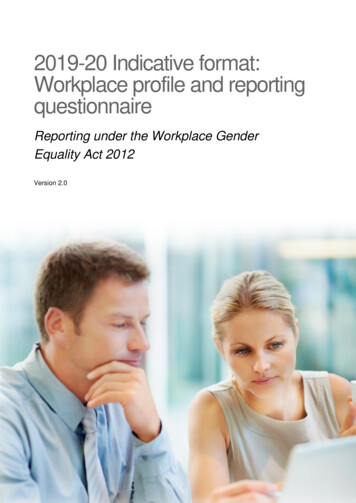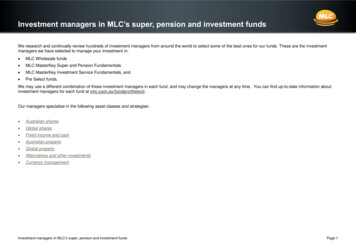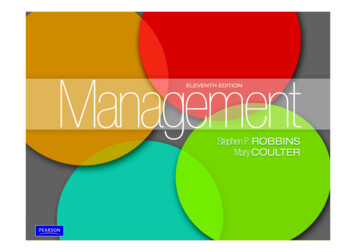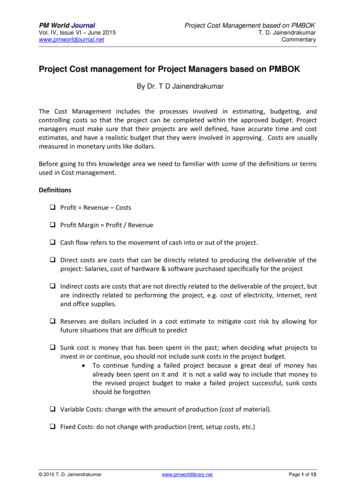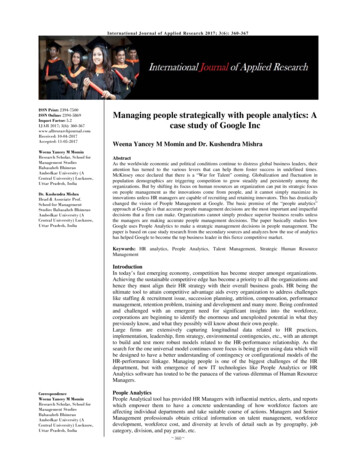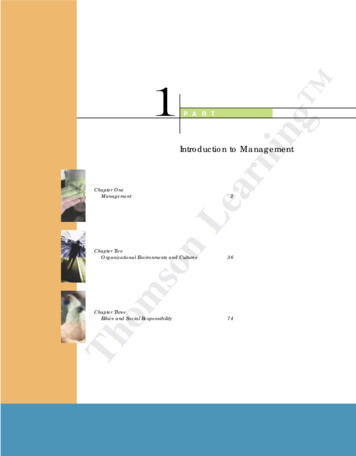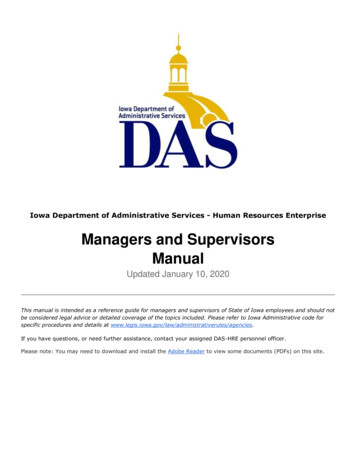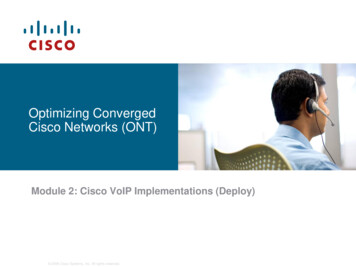
Transcription
OBJECTIVES Explain how managers can use bundlingand tying strategies to increase profitwhen customers have heterogeneoustastes Explain how firms use transfer pricing toprovide incentives to wholly-ownedsubsidiaries and divisions and to shelterprofit from taxes in a global environment
DEFINITIONS Simple bundling: When managersoffer several products or services asone package so consumers do nothave an option to purchase packagecomponents separately Example: Inclusion of a service contractwith a product
DEFINITIONS Mixed bundling: Allows consumers topurchase package components eitheras a single unit or separately The bundle price is generally less thanthe sum of the prices of the individualcomponents. Examples: Season tickets to sportingevents or value meals at McDonald’s
DEFINITIONS Negative correlation: When somecustomers have higher reservationprices for one item in the bundle butlower reservation prices for anotheritem in the bundle, whereas anothergroup of customers has the reversepreferences Managers form bundles so as toincrease profit by creating negativecorrelations across consumers.
THE MECHANICS OF BUNDLING Advantages of bundling Bundling can increase the seller’s profit, ascustomers have varied tastes. Bundling can emulate first-degree pricediscrimination when it is not otherwise possiblebecause individual reservation prices cannot bedetermined or laws prohibit price discrimination. Bundling does not require knowledge ofindividual consumers’ reservation prices, butonly the distribution of consumers’ reservationprices.
THE MECHANICS OF BUNDLING Strategies Assumption: Goods are independent,so the value of a bundle is equal tothe sum of the reservation prices ofthe goods in the bundle. Separate pricing: Goods are notbundled. Prices are set equal to profit-maximizingmonopoly prices.
THE MECHANICS OF BUNDLING Strategies (cont’d) Pure bundling Bundle price is set to maximize profit. Mixed bundling Bundle price and individual goodprices are set to maximize profit. Optimal strategy is that whichmaximizes profit.
THE MECHANICS OF BUNDLING Example Figures Notation ri Reservation price of good i pi# Price charged for good i PB# Price of bundle
THE MECHANICS OF BUNDLING Example Figures (cont’d) Figure 10.1: Price Separately If r1 p1# and r2 p2#, then consumerbuys neither good. If r1 p1# and r2 p2#, then consumerbuys only good 1. If r1 p1# and r2 p2#, then consumerbuys only good 2. If r1 p1# and r2 p2#, then consumerbuys both goods.
PRICE SEPARATELYManagerial Economics, 8eCopyright @ W.W. & Company 2013
THE MECHANICS OF BUNDLING Figure 10.2: Pure Bundling If (r1 r2) PB#, then consumer does not buy thebundle. If (r1 r2) PB#, then consumer buys the bundle. Figure 10.3: Mixed Bundling Buy neither good nor bundle: (r1 r2) PB#, r1 p1#,and r2 p2# Buy bundle: (r1 r2) PB# Buy good 1 only: r1 p1#, r2 p2#, and r2 (PB# – p1#) Buy good 2 only: r2 p2#, r1 p1#, and r1 (PB# – p2#)
PURE BUNDLINGManagerial Economics, 8eCopyright @ W.W. & Company 2013
MIXED BUNDLINGManagerial Economics, 8eCopyright @ W.W. & Company 2013
THE MECHANICS OF BUNDLING Example 1 Assumptions Perfect negative correlation amongconsumer reservation prices (Figure 10.4) No variation in total bundle valuation; allvalue the bundle at 100. Unit cost of production for each good 1 Table 10.1: Consumer ReservationPrices Table 10.2: Optimal Separate Prices forGood 1 and Good 2: Profit 264
EXAMPLE OF PERFECT NEGATIVECORRELATION OF CONSUMERS’Reservation PricesManagerial Economics, 8eCopyright @ W.W. & Company 2013
2013 W. W. Norton Co., Inc.
2013 W. W. Norton Co., Inc.
THE MECHANICS OF BUNDLING Example 1 Table 10.3: Optimal Pure Bundle Price forConsumers A, B, C, and D: Profit 392 Table 10.4: Optimal Mixed Bundle Prices:Profit 392 Table 10.5: Optimal Mixed Bundle PricesWhen Consumers Buy Bundle and at LeastOne of the Separately Priced Goods: Profit 373.98
2013 W. W. Norton Co., Inc.
2013 W. W. Norton Co., Inc.
2013 W. W. Norton Co., Inc.
THE MECHANICS OF BUNDLING Definitions Credibility of the bundle: When managerscorrectly anticipate which customers willpurchase the bundle or the goods separately Extraction: When the manager extracts theentire consumer surplus from each customer Exclusion: When the manager does not sell agood to a customer who values the good atless than the cost of producing it Inclusion: When a manager sells a good to aconsumer who values the good at greaterthan the seller’s cost of producing the good
THE MECHANICS OF BUNDLING Definitions Extraction, exclusion, and inclusion areall satisfied by perfect pricediscrimination. Pricing separately will satisfy exclusionbut will not result in complete extractionor inclusion.
THE MECHANICS OF BUNDLING Definitions (cont’d) Pure bundling can result in completeextraction, but if consumer reservationprices do not have a perfect negativecorrelation, extraction will be less thancomplete. It is also possible for purebundling to fail to attain full inclusion andexclusion. The profit from mixed bundling is alwaysequal to or better than that of pricingseparately or pure bundling.
THE MECHANICS OF BUNDLING Example 2 Assumptions Perfect negative correlation amongconsumer reservation prices No variation in total bundle valuation; allvalue the bundle at 100. Unit cost of production for each good 11
THE MECHANICS OF BUNDLING Example 2 (cont’d) Table 10.6: Optimal Separate Prices for Good1 and Good 2: Profit 204 Table 10.7: Optimal Pure Bundle Price forConsumers A, B, C, and D: Profit 312 Table 10.8: Optimal Mixed Bundle Prices:Profit 312 Table 10.9: Optimal Mixed Bundle PricesWhen Consumers Buy Bundle and at LeastOne of the Separately Priced Goods: Profit 313.98
2013 W. W. Norton Co., Inc.
2013 W. W. Norton Co., Inc.
2013 W. W. Norton Co., Inc.
2013 W. W. Norton Co., Inc.
THE MECHANICS OF BUNDLING Example 3 Assumptions Perfect negative correlation amongconsumer reservation prices No variation in total bundle valuation; allvalue the bundle at 100. Unit cost of production for each good 55
THE MECHANICS OF BUNDLING Example 3 (cont’d) Table 10.10: Optimal Separate Prices forGood 1 and Good 2: Profit 70 Table 10.11: Optimal Pure Bundle Price forConsumers A, B, C, and D: Profit 0 Table 10.12: Optimal Mixed Bundle Prices atAny Pure Bundle Price over 100 (So NoBundle Is Purchased): Profit 70
2013 W. W. Norton Co., Inc.
2013 W. W. Norton Co., Inc.
2013 W. W. Norton Co., Inc.
THE MECHANICS OF BUNDLING Conclusions from Examples 1–3: Whenreservation prices are negativelycorrelated When production cost is low, pure bundlingwill extract all consumer surplus. When production cost rises, mixed bundling isbest. When production cost rises further, separatepricing is best.
THE MECHANICS OF BUNDLING Conclusions from Examples 1–3:When reservation prices arenegatively correlated (cont’d) The optimal separate prices are alwaysequal to consumers’ reservation prices. The optimal pure bundle price is alwaysequal to the sum of consumers’reservation prices. The optimal mixed bundle prices are notnecessarily equal to reservation pricesor their sum.
THE MECHANICS OF BUNDLING Example 4 Assumptions Distribution of reservation prices is uniform overthe range 0 to 100 for each good. Correlation is zero. There are 10,000 customers. Production cost is zero. Figure 10.5: Optimal Separate Prices in theCase of Uniformly Distributed ConsumerReservation Prices: Profit 500,000
OPTIMAL SEPARATE PRICES IN THE CASE OF UNIFORMLYDISTRIBUTED CONSUMER RESERVATION PRICESManagerial Economics, 8eCopyright @ W.W. & Company 2013
THE MECHANICS OF BUNDLING Example 4 Figure 10.6: Optimal Pure Bundle Pricein the Case of Uniformly DistributedReservation Prices: Profit 544,331.10 Figure 10.7: Optimal Mixed BundlePricing in the Case of UniformlyDistributed Reservation Prices: Profit 549,201
OPTIMAL PURE BUNDLE PRICE IN THE CASE OF UNIFORMLYDISTRIBUTED CONSUMER RESERVATION PRICESManagerial Economics, 8eCopyright @ W.W. & Company 2013
OPTIMAL MIXED BUNDLE PRICING IN THE CASE OF UNIFORMLYDISTRIBUTED CONSUMER RESERVATION PRICESManagerial Economics, 8eCopyright @ W.W. & Company 2013
THE MECHANICS OF BUNDLING Example 5 Assumptions Quantity discounting is a form of mixedbundling. Unit cost of production for each good 1 Table 10.13: Reservation Prices for the First andSecond Units of a Good by Consumers A and B Table 10.14: Optimal Separate Prices for theGood: Profit 6
2013 W. W. Norton Co., Inc.
2013 W. W. Norton Co., Inc.
THE MECHANICS OF BUNDLING Example 5 (cont’d) Table 10.15: Optimal Pure Bundle Price forTwo Units of the Good: Profit 7 Table 10.16: Optimal Mixed Bundling Pricesfor the Case of a Single Good:Profit 7.99
2013 W. W. Norton Co., Inc.
2013 W. W. Norton Co., Inc.
THE MECHANICS OF BUNDLING Example 6 Assumptions Three consumers with negatively correlatedreservation prices Each consumer wants no more than one unit ofeach of two goods. Cost of production is 4. Table 10.17: Consumer Reservation Prices forGood X and Good Y (in Dollars) Table 10.18: Best Separate Price Strategy: Profit 16.00
2013 W. W. Norton Co., Inc.
2013 W. W. Norton Co., Inc.
THE MECHANICS OF BUNDLING Example (cont’d) Table 10.19: Best Pure Bundling Strategy:Profit 15.99 Table 10.20: Best Mixed Bundling Strategy:Profit 17.97
2013 W. W. Norton Co., Inc.
2013 W. W. Norton Co., Inc.
WHEN TO UNBUNDLE Example Assumptions Three consumers with negativelycorrelated reservation prices Each consumer wants no more thanone unit of each of two goods.
WHEN TO UNBUNDLE Example (cont’d) Table 10.21: The Reservation Prices forConsumers A, B, and C for Good X,Good Y, and a Bundle of Good X andGood Y Figure 10.8: Depiction of BundlingProblem in Table 10.21 (cost 3) Pure bundling gives the lowest profit. Mixed bundling gives the highest profit. Ignore crow’s feet (blue lines)
2013 W. W. Norton Co., Inc.
DEPICTION OF BUNDLING PROBLEM INTABLE 10.21Managerial Economics, 8eCopyright @ W.W. & Company 2013
BUNDLING AS A PREEMPTIVE ENTRYSTRATEGY Bundling can be used to deter entry. Assumptions The bundle offered by Alpha Company ismade up of W and S, has a cost of 4, and willbe priced at X. The Beta Company is developing C, whichhas a cost of 2 and is a close substitute for W.
BUNDLING AS A PREEMPTIVE ENTRYSTRATEGY Assumptions (cont’d) The Gamma Company is developing N thathas a cost of 2 and is a close substitute for S. Only Alpha has the assets to produce abundle. Alpha’s entry cost to the market with a bundleis 30. Entry cost for each product individuallyis 15. Beta’s entry cost to the market is 17. Gamma’s entry cost to the market is 17. Demand for the goods are perfectly negativelycorrelated.
BUNDLING AS A PREEMPTIVE ENTRYSTRATEGY Example Table 10.22: Reservation Prices forConsumers A, B, and C for Good W or C,Good S or N, and a Bundle of Good W andGood S or a Bundle of Good C and Good N
2013 W. W. Norton Co., Inc.
If Alpha charges 15.33 for each bundle, itwill cover the cost of entry plus the cost ofeach bundle 30 (4*3) 42. Profit will be 46-42 4. Neither Beta or Gamma will enter becauseneither can cover the cost of entry plus theper unit cost of each item.Managerial Economics, 8eCopyright @ W.W. & Company 2013
TYING AT IBM, XEROX, AND MICROSOFT Tying: Pricing technique in whichmanagers sell a product that needs acomplementary product This is a form of bundling that applies tocomplementary products. Tying requires market power. Tying may be used to protect a monopoly. Tying may be used to ensure that a firm’sproduct works properly and its brand name isprotected. Examples: Maintenance contracts and franchiserequirements
TYING AT IBM, XEROX, AND MICROSOFT Examples Xerox required customers who leasedcopy machines to use Xerox paper. IBM required customers who leasedcomputers to use IBM punch cards. Microsoft forced customers to useInternet Explorer with its operatingsystem in order to exclude Netscapeand protect its monopoly.
TRANSFER PRICING Transfer price: Payment thatsimulates a market where no formalmarket exists Refers to intrafirm pricing among whollyowned subsidiaries or divisions. The purpose of transfer prices: Encourage profit-maximizing or costminimizing behavior by providing anincentive Measure the performance of semiautonomous divisions
TRANSFER PRICING Notation (MRD – MCD)MPU MCU In the absence of an external market, theoptimal transfer price is the marginal cost ofthe upstream product (MCU) when the optimalquantity (QU) is produced. (MRD – MCD) is the difference between thedownstream Marginal Revenue and MarginalCost.
DETERMINATION OF THE TRANSFER PRICE, GIVEN NOEXTERNAL MARKET FOR THE TRANSFERRED GOODManagerial Economics, 8eCopyright @ W.W. & Company 2013
TRANSFER PRICING: A PERFECTLY COMPETITIVEMARKET FOR THE UPSTREAM PRODUCT The optimal transfer price is the competitivemarket price. Example: Figure 10.10: Determination of theTransfer Price, Given a Perfectly CompetitiveExternal Market for the Transferred Product
DETERMINATION OF THE TRANSFER PRICE, GIVEN APERFECTLY COMPETITIVE EXTERNAL MARKET FOR THETRANSFERRED PRODUCTManagerial Economics, 8eCopyright @ W.W. & Company 2013
THE GLOBAL USE OF TRANSFER PRICING For international transfers, the mostcommon methods of determining transferprices are market-based transfer pricesand full productions costs plus a markup. A comparison with the results of an earlierstudy indicates that the market-based transferprices are increasingly being used.
THE GLOBAL USE OF TRANSFER PRICING Managers can use transfer pricing to shiftprofits between divisions to minimize taxliability. Increase profit in low-tax countries anddecrease profit in high-tax countries
THE GLOBAL USE OF TRANSFER PRICING Notation and implication Assume there is no external market for theupstream product and that all profits areexpressed in the same currency. Tax rate in a downstream country Tax rate in an upstream country, where
THE GLOBAL USE OF TRANSFER PRICING Notation and implication (cont’d) After-tax profit in the downstream country (1 – )(TRD – TCD – PUQU) After-tax profit in the upstream country (1 – )(PUQU – TCU) Total after-tax profit (1 – )(TRD – TCD) – (1 – )(TCU) ( – )(PUQU) Increasing the transfer price (PU) will increase aftertax profit if .
THE GLOBAL USE OF TRANSFER PRICING Reasons for the importance of globaltransfer prices: Increased globalization Different level of taxation in variouscountries Greater scrutiny by tax authorities Inconsistent rules and laws in differenttax jurisdictions
THE GLOBAL USE OF TRANSFER PRICING Transfer price policies that causethe fewest problems: Comparable uncontrolled price as ifthey are not related. (arms-lengthprice) Cost-plus prices, using the armslength markup Resale price
Consumers A, B, and C for Good X, Good Y, and a Bundle of Good X and Good Y Figure 10.8: Depiction of Bundling Problem in Table 10.21 (cost 3) Pure bundling gives the lowest profit. Mixed bundling gives the highest

